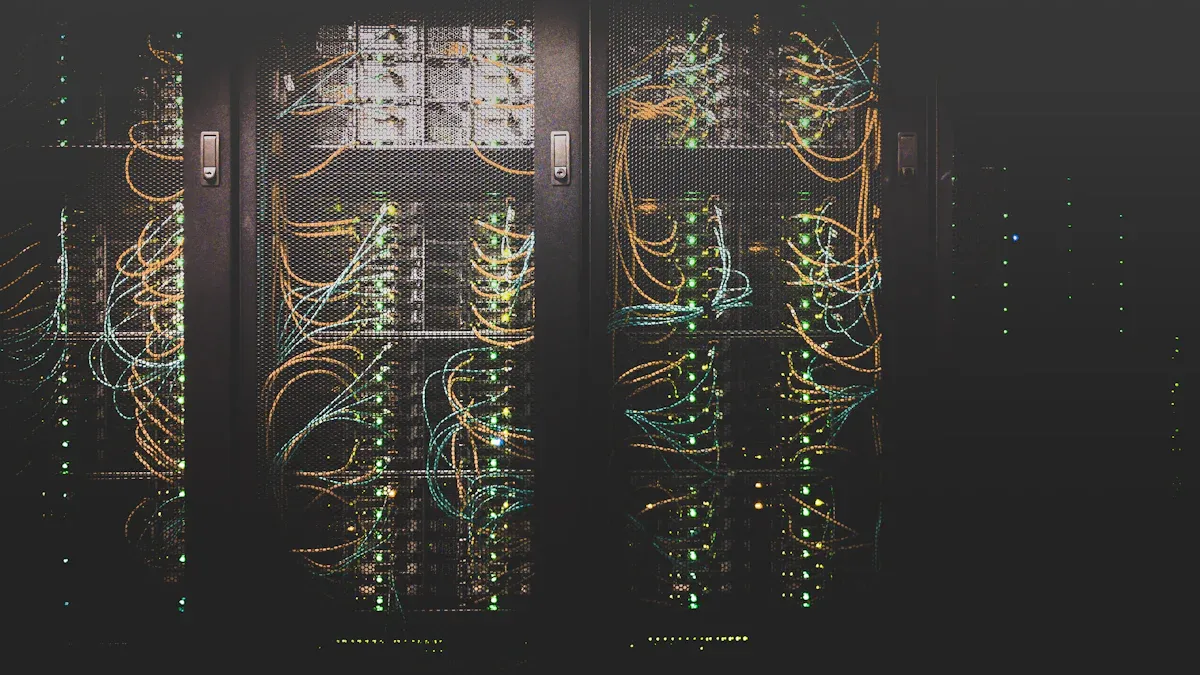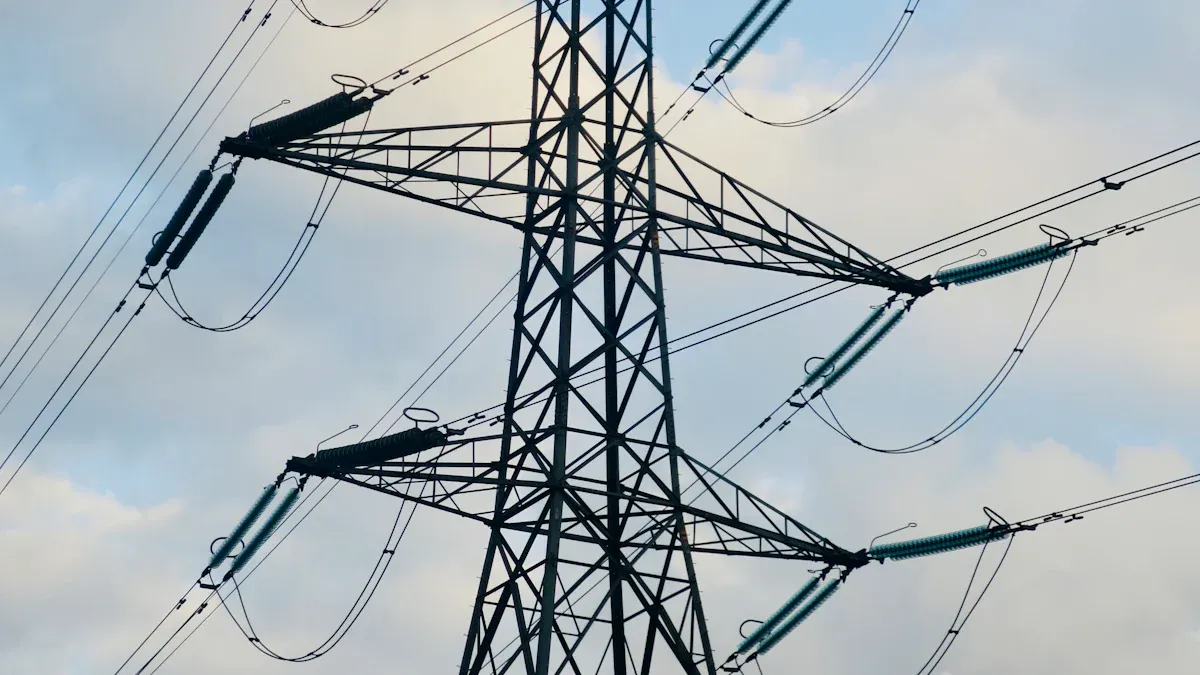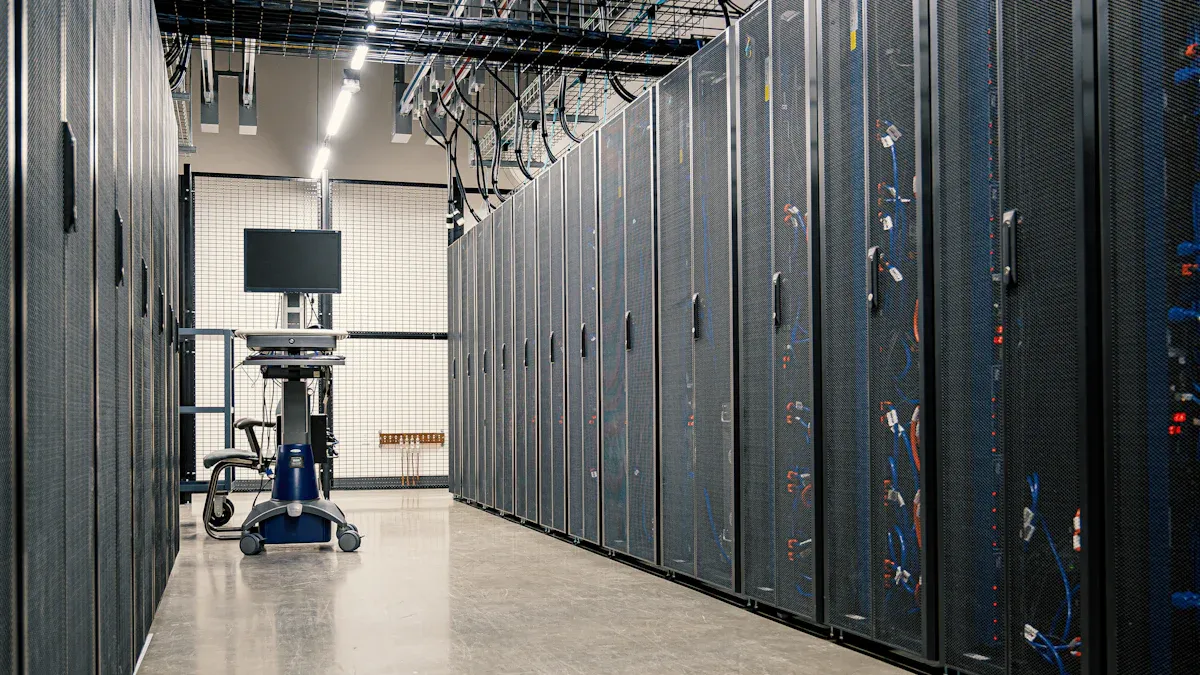
Intelligent PDUs deliver advanced control and monitoring, supporting energy savings, downtime reduction, and greater operational efficiency. A basic PDU provides dependable power distribution with simplicity. Organizations often select intelligent options for features like remote management, scalability, and sustainability.
| Reason for Choosing Intelligent PDUs | Key Benefit |
|---|---|
| Energy Savings | Up to 30% lower energy costs |
| Downtime Reduction | 25% less unplanned downtime |
| Enhanced Efficiency | Remote monitoring and management |
Key Takeaways
- Intelligent PDUs offer real-time monitoring, remote control, and energy-saving features that help reduce downtime and lower costs.
- Basic PDUs provide simple, reliable power distribution without advanced monitoring, making them suitable for small or budget-conscious setups.
- Choosing the right PDU depends on your power needs, scalability plans, and goals for efficiency and management.
PDU Types Explained

Basic PDU Overview
A basic PDU serves as a straightforward solution for distributing electrical power to multiple devices. Manufacturers design these units for reliability and simplicity, making them ideal for small server rooms, offices, and retail spaces. Basic PDUs typically feature a plug-and-play installation, supporting input power capacities up to 67kVA and a range of voltages. They comply with international safety standards such as UL, CE, and RoHS.
Note: Basic PDUs do not offer real-time monitoring or remote management. Users cannot track power usage, receive alerts, or monitor environmental conditions directly through the device. This limitation restricts their use to environments where advanced oversight is unnecessary.
Key characteristics of basic PDUs include:
- No data collection or analytics
- Limited scalability for expanding IT needs
- Absence of remote access and alerts
Intelligent PDU Overview
Intelligent PDUs represent the next step in power management technology. These advanced devices provide comprehensive monitoring, control, and management capabilities. They support real-time power quality monitoring with high metering accuracy, remote accessibility, and integration with data center infrastructure management (DCIM) software.
| Feature | Intelligent PDU Capability |
|---|---|
| Monitoring | Real-time voltage, current, and power consumption |
| Control | Remote outlet switching and scheduling |
| Security | Advanced encryption and ISO27001 certification |
| Environmental Sensing | Optional sensors for temperature, humidity, and airflow |
| Scalability | High-density design and swappable components |
Intelligent PDUs help organizations optimize energy use, enhance uptime, and future-proof their power infrastructure. They suit enterprise data centers, colocation facilities, and smart buildings that require integrated power management and advanced security.
PDU Feature Comparison

Monitoring and Data Collection
Monitoring and data collection capabilities set intelligent PDUs apart from basic models. Basic PDUs function as simple power strips, supplying electricity to multiple devices without tracking usage or providing analytics. They do not measure power at the outlet or device level, nor do they collect any data from connected equipment.
Intelligent PDUs, on the other hand, feature embedded intelligence modules that enable comprehensive measurement and monitoring. These advanced units can track voltage, current, active and apparent power, energy consumption, and power factor. Some models offer outlet-level metering, providing granular insights into the power usage of each connected device. Intelligent PDUs also support remote data access, real-time monitoring, historical data review, and alarm notifications. This level of visibility allows organizations to optimize energy use and quickly identify inefficiencies.
| Data/Feature Type | Intelligent PDUs | Basic PDUs |
|---|---|---|
| Power Metrics | Voltage, Current, Active Power, Energy, Power Factor | Not available |
| Remote Data Access | Web, SNMP, SSH, REST APIs | Not available |
| Outlet Control (Switching) | Remote control of individual outlets | Not available |
| Environmental Monitoring | Temperature, humidity, airflow sensors | Not available |
| Integration | DCIM/BMS system compatibility | Not available |
| Monitoring Capabilities | Real-time and historical data | None |
Intelligent PDUs provide the data-driven foundation for proactive power management, while basic PDUs offer only reliable power delivery.
Remote Control and Access
Remote control and access capabilities distinguish intelligent PDUs from their basic counterparts. Basic PDUs require physical presence for any changes or troubleshooting. They lack network connectivity and do not support remote management.
Intelligent PDUs enable full remote monitoring and control. Administrators can manage power distribution, perform outlet-level power cycling, and update firmware from anywhere using secure network protocols such as SNMP, HTTPS, SSH, and REST APIs. These features allow IT teams to reboot unresponsive devices, balance loads, and receive proactive alerts for power issues without being on-site. Centralized management tools further streamline configuration changes and firmware updates, reducing operational overhead.
| Feature | Basic PDUs | Intelligent PDUs |
|---|---|---|
| Remote Management | Not available | Available; control from remote locations |
| Outlet-Level Power Cycling | Not available | Available; remote rebooting of individual outlets |
| Real-Time Power Monitoring | Not available | Available; tracks current, voltage, power consumption |
| Alarm Thresholds & Alerts | Not available | Available; proactive notifications for power issues |
| Environmental Monitoring | Not available | Available; monitors temperature, humidity, etc. |
| Advanced Connectivity | Not available | Available; wireless and network integration |
Intelligent PDUs transform power management from a manual process to an automated, remotely accessible system, improving response times and reducing downtime.
Energy Efficiency and Reporting
Energy efficiency and reporting capabilities play a critical role in modern data centers. Basic PDUs do not provide any energy usage data or reporting features. Facility managers cannot track consumption or identify inefficiencies, which limits opportunities for energy savings.
Intelligent PDUs deliver granular control and real-time monitoring at the rack and outlet level. They generate comprehensive reports on power consumption, temperature, humidity, and airflow. These reports help facility managers identify energy waste, optimize cooling, and implement energy-saving measures. Advanced reporting includes historical data analysis, trend identification, and capacity planning. Real-time alerts and remote monitoring further support proactive management, reducing energy wastage and downtime.
- Intelligent PDUs enable:
- Tracking energy consumption at the device level
- Identifying carbon-intensive equipment
- Implementing energy-saving measures through trend analysis
- Centralized management for load balancing and optimization
Real-time visibility and advanced reporting from intelligent PDUs empower organizations to improve sustainability and reduce operational costs.
Scalability and Flexibility
Scalability and flexibility are essential for growing IT environments. Basic PDUs provide reliable power delivery but lack features that support expansion or adaptation. They do not offer real-time monitoring, outlet-level metering, or remote switching, which limits their suitability for high-density or rapidly growing data centers.
Intelligent PDUs support seamless scalability through modular designs, high-density outlet technology, and cascading capabilities. Organizations can add or replace components without downtime, customize configurations for different equipment, and network multiple PDUs for centralized management. Integration with DCIM systems enables real-time monitoring and control, supporting modular growth and efficient power management.
- Key flexibility features of intelligent PDUs:
- Modular design for easy expansion and upgrades
- Customizable outlet types and communication modules
- Hot-swappable components and rotatable displays
- Centralized management for scalable power distribution
Intelligent PDUs provide the adaptability required for future expansion, ensuring that power infrastructure keeps pace with evolving IT demands.
Cost and Value
Cost and value considerations often influence the choice between basic and intelligent PDUs. Basic PDUs offer a cost-effective solution for straightforward power distribution needs. They suit budget-conscious operations where advanced monitoring and control are unnecessary.
Intelligent PDUs require a higher upfront investment but deliver significant long-term value. Features such as real-time monitoring, remote management, environmental sensing, and overload protection enhance operational efficiency and reduce downtime. Outlet-level power usage tracking helps identify underutilized devices, enabling energy savings and extending equipment lifespan. Remote management reduces the need for on-site maintenance, cutting labor costs. These benefits justify the investment, especially in high-demand or mission-critical environments.
| PDU Type | Key Features | Cost Consideration |
|---|---|---|
| Basic PDUs | Reliable, cost-effective, versatile | Suitable for budget-conscious operations |
| Advanced PDUs (Metered/Smart) | Real-time monitoring, overload protection, remote management | Higher upfront cost, justified by long-term savings and critical setup needs |
Intelligent PDUs support business continuity and operational excellence, making them a strategic investment for organizations focused on reliability and growth.
PDU Comparison Table
A well-structured comparison table allows organizations to evaluate essential features and performance metrics side by side. This approach simplifies the selection process and ensures that the chosen solution aligns with both current and future operational needs. Key metrics such as power capacity, outlet configuration, safety features, and monitoring capabilities play a significant role in determining the right fit for any environment.
| Key Metric | Description / Importance | Example Options |
|---|---|---|
| Power Capacity | Maximum current supported; matches load requirements | 16A, 20A, 63A |
| Outlet Configuration | Number and type of outlets; ensures device compatibility | IEC C13, NEMA, mixed types |
| Safety Features | Surge protection, overload prevention, circuit breakers | Present in most models |
| Monitoring Features | Real-time energy tracking, remote management, environmental sensors | Advanced in intelligent models |
| Price Range | Budget to premium; helps balance cost and features | $ to $$$ |
| Form Factor | Physical design; rack-mounted, horizontal, vertical, compact | Rack, vertical, horizontal |
| Customization | Ability to tailor capacity, outlets, and cables | Extensive in some brands |
| Durability | Build quality for industrial or data center use | Metal shells, robust construction |
| Unique Strengths | Distinctive features such as firmware upgrades or intuitive interfaces | Brand-specific advantages |
A comparison table helps organizations assess power requirements, outlet compatibility, and safety features at a glance. This method supports informed purchasing decisions by highlighting differences in monitoring, scalability, and cost-effectiveness.
- Organizations can:
- Evaluate scalability through modular designs and real-time monitoring.
- Balance initial investment with long-term savings by comparing warranty terms and energy efficiency.
- Ensure compatibility with existing systems and future growth plans.
A clear comparison table streamlines the decision-making process, helping teams select the most suitable PDU for their operational goals.
PDU Use Cases
Best Scenarios for Basic PDUs
Basic PDUs work best in environments where simplicity and cost efficiency matter most. Small businesses, home offices, and simple IT setups often rely on these units for dependable power distribution. Many organizations choose basic PDUs for edge computing deployments that do not require advanced monitoring or remote management. These devices function like high-capacity power strips, distributing electricity from a single source to multiple outlets.
Basic PDUs remain a popular choice in settings where power needs are straightforward and budgets are tight. They provide reliable service without the complexity of network connectivity or data collection.
However, basic PDUs have limitations. They do not offer insight into power usage or allow remote control. In mission-critical environments, these shortcomings can lead to unplanned outages, increased energy costs, and downtime. Data centers and other high-stakes operations often avoid basic PDUs because they lack the advanced features needed to minimize risk and ensure reliability.
Best Scenarios for Intelligent PDUs
Intelligent PDUs play a vital role in modern IT infrastructures. Data centers, colocation facilities, and remote sites benefit from their advanced monitoring and control features. These devices support real-time power usage tracking at both the rack and outlet levels. Remote management capabilities allow teams to reboot equipment, balance loads, and respond to issues quickly, even from off-site locations.
- Intelligent PDUs excel in:
- Mission-critical environments that demand continuous uptime
- Facilities requiring energy efficiency and detailed reporting
- Locations with limited physical access, such as disaster recovery sites
- Regulated industries needing compliance and security features
Environmental sensors in intelligent PDUs help optimize cooling and prevent equipment damage. Certifications like ISO9001 and UL ensure these devices meet strict safety and reliability standards. Organizations use intelligent PDUs to reduce energy waste, improve operational efficiency, and support future growth.
Choosing the Right PDU
Evaluating Power Management Needs
Selecting the right power distribution solution begins with a thorough assessment of power management requirements. Organizations face increasing demand for data processing and storage, which drives the need for robust and scalable power management. Sustainability objectives also influence the adoption of energy-efficient and renewable solutions.
Key considerations include:
- Assessing power and cooling requirements at the rack, row, and room levels.
- Evaluating space, cable management, airflow, and weight capacity for each rack.
- Forecasting future equipment needs to ensure scalability.
- Reviewing integration challenges with legacy systems.
- Considering the regulatory environment and energy cost implications.
- Analyzing the availability and quality of the power supply, including regional constraints and transmission capacity.
- Planning for modular and scalable designs to accommodate growth.
Power management strategies must address the volatility of energy markets and the risk of grid congestion. Some organizations deploy behind-the-meter power generation, such as fuel cells, to secure reliable and redundant power. These approaches help maintain uptime and support mission-critical operations.
Emerging technologies like AI and machine learning now play a role in optimizing power distribution and cooling. Environmental sensors and real-time monitoring further enhance the ability to prevent equipment failure and downtime. By evaluating these factors, organizations can select a solution that meets both current and future operational demands.
Aligning PDU Features with Business Goals
Aligning the features of a power distribution unit with business objectives leads to measurable improvements in efficiency and cost savings. Intelligent solutions support goals such as operational efficiency, energy savings, system reliability, and sustainability.
Organizations benefit from:
- Real-time monitoring of energy consumption, which helps identify inefficiencies and prevent overloads.
- Environmental monitoring that reduces risks like overheating and extends equipment lifespan.
- Remote management capabilities that minimize downtime and allow for proactive maintenance.
- Energy-saving modes and intelligent load balancing, which lower operational costs.
- Modular and scalable designs that support business growth without disrupting operations.
- Integration with automation platforms and DCIM systems, enabling unified infrastructure management.
Companies have reported up to 30% energy savings and significant improvements in uptime by leveraging intelligent power distribution solutions. For example, remote management features have enabled data centers to power down unused equipment, resulting in substantial reductions in electricity bills.
Advanced reporting and predictive analytics support capacity planning and strategic decision-making. These features help organizations forecast future energy needs, optimize resource allocation, and implement energy-saving strategies. By aligning power management capabilities with business objectives, companies can maximize operational performance and achieve long-term cost efficiency.
Intelligent PDUs deliver advanced monitoring, remote control, and scalability, supporting operational efficiency and future growth. Facilities with straightforward needs may select a basic PDU for cost savings. Organizations should assess power management requirements and plan for expansion to avoid common mistakes and ensure reliable, efficient operations.
FAQ
What is the main difference between a basic PDU and an intelligent PDU?
A basic PDU distributes power without monitoring. An intelligent PDU provides real-time data, remote management, and advanced control features.
Can intelligent PDUs help reduce energy costs?
Yes. Intelligent PDUs track energy usage, identify inefficiencies, and support energy-saving strategies. Many organizations report lower utility bills after implementation.
Are intelligent PDUs necessary for small businesses?
Small businesses with simple power needs often choose basic PDUs. Intelligent PDUs become valuable when remote management, monitoring, or scalability is required.
Post time: Jul-21-2025

